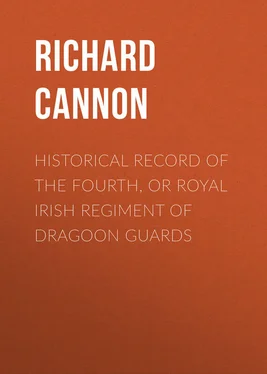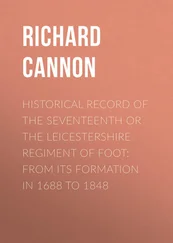Richard Cannon - Historical Record of the Fourth, or Royal Irish Regiment of Dragoon Guards
Здесь есть возможность читать онлайн «Richard Cannon - Historical Record of the Fourth, or Royal Irish Regiment of Dragoon Guards» — ознакомительный отрывок электронной книги совершенно бесплатно, а после прочтения отрывка купить полную версию. В некоторых случаях можно слушать аудио, скачать через торрент в формате fb2 и присутствует краткое содержание. Жанр: foreign_antique, foreign_prose, на английском языке. Описание произведения, (предисловие) а так же отзывы посетителей доступны на портале библиотеки ЛибКат.
- Название:Historical Record of the Fourth, or Royal Irish Regiment of Dragoon Guards
- Автор:
- Жанр:
- Год:неизвестен
- ISBN:нет данных
- Рейтинг книги:4 / 5. Голосов: 1
-
Избранное:Добавить в избранное
- Отзывы:
-
Ваша оценка:
- 80
- 1
- 2
- 3
- 4
- 5
Historical Record of the Fourth, or Royal Irish Regiment of Dragoon Guards: краткое содержание, описание и аннотация
Предлагаем к чтению аннотацию, описание, краткое содержание или предисловие (зависит от того, что написал сам автор книги «Historical Record of the Fourth, or Royal Irish Regiment of Dragoon Guards»). Если вы не нашли необходимую информацию о книге — напишите в комментариях, мы постараемся отыскать её.
Historical Record of the Fourth, or Royal Irish Regiment of Dragoon Guards — читать онлайн ознакомительный отрывок
Ниже представлен текст книги, разбитый по страницам. Система сохранения места последней прочитанной страницы, позволяет с удобством читать онлайн бесплатно книгу «Historical Record of the Fourth, or Royal Irish Regiment of Dragoon Guards», без необходимости каждый раз заново искать на чём Вы остановились. Поставьте закладку, и сможете в любой момент перейти на страницу, на которой закончили чтение.
Интервал:
Закладка:
Having been relieved from the King's duty, Arran's Cuirassiers marched to Richmond and adjacent villages in May, 1688; and in July they once more encamped on Hounslow Heath. After taking part in several reviews, mock-battles, and splendid military spectacles, which were exhibited on the Heath by a numerous army, they proceeded to Cambridge, Peterborough, and St. Ives, and afterwards to Ipswich, where they were stationed a short time under Major-General Sir John Lanier, but were suddenly ordered to march to London in the beginning of November.
The circumstances in which the loyal officers and soldiers of the King's army were placed were of a most painful character. The King had been making rapid advances towards the subversion of the established religion and laws of the kingdom; and loyalty to the sovereign, – a distinguished feature in the character of the British soldier, and the love of the best interests of their native country, – which is inherent in men, were become so opposed to each other, that it appeared necessary for one to be sacrificed. Arran's Cuirassiers were, however, spared this painful ordeal by the circumstances which occurred. The King had resolved to remodel his army in England by the dismissal of Protestants and the introduction of Papists, as he had already done in Ireland; but the arrival of the Prince of Orange, with a Dutch army to aid the English nobility in opposing the proceedings of the Court, overturned the King's measures. The loyalty and attachment to the King evinced by the Earl of Arran occasioned him to be promoted to the rank of Brigadier-General, and his regiment was considered one of the corps on which dependence could be placed. It had completed an augmentation of ten men per troop ordered in September, and was selected to remain as a guard near the Queen and the infant Prince of Wales, who was afterwards known as the Pretender: but a defection appearing in the army, the infant Prince was sent to Portsmouth; and the regiment, having been released from its duty of attendance on the Queen, was ordered to march to Salisbury.
Many officers and soldiers joined the Prince of Orange, and amongst others, Lord Churchill, Colonel of the third troop of Life Guards; the King gave the Duke of Berwick the command of the third troop of Life Guards; removed the Earl of Arran to the Royal Regiment of Horse Guards; and conferred the Colonelcy of the Sixth Horse on the Earl's brother, Charles Earl of Selkirk, from Guidon and Major in the fourth troop of Life Guards, his commission bearing date the 20th of November, 1688.
The desertions which took place alarmed the King and Queen; Her Majesty fled with the infant Prince to France, and was followed by the King. The Prince of Orange assumed the reins of government, and the Earl of Selkirk's regiment was ordered to march to Stamford in Lincolnshire.
On the 31st of December, 1688, the Prince of Orange conferred the Colonelcy of the regiment on Colonel Charles Godfrey, who had previously held a commission in the Duke of Monmouth's regiment of horse.
The Prince and Princess of Orange having ascended the throne while the regiment was quartered in Lincolnshire, it took part in the solemnity of the proclamation of their Majesty's accession at Stamford, on the 16th of February, 1689, on which occasion three troops, with the trumpets and kettle drums, paraded the town, and, 'after firing several volleys, partook of a substantial repast, with abundance of wine, and drank their Majesties' health amidst reiterated acclamations.'
In the middle of March three troops proceeded to the Isle of Wight, where 1500 Irish Roman Catholics were detained in the custody of a military force. These men had entered the service of King James in Ireland, and had been ordered to England to support the arbitrary proceedings of the Court; at the Revolution they were deprived of their arms and sent prisoners to the Isle of Wight, from whence they were eventually transported to Hamburgh, to be disposed of in the service of the Emperor of Germany.
Thirty men and horses of the regiment were transferred, in April, to the Blues, to complete the establishment of that corps previous to its embarkation for Holland.
During the summer three troops of the Sixth Horse were encamped on Hounslow Heath. King William had reasons to suspect that several old corps were not well affected towards his interests; but His Majesty appears to have placed entire confidence in the attachment of the officers and men of this regiment to his person and government; and in August a strong detachment left the camp at Hounslow, to take part in the duties of the Court and metropolis. The remainder of the three troops of the Sixth Horse, encamped on the heath, proceeded into quarters at Croydon and Mitcham; and in December, the three troops in the Isle of Wight were removed to Salisbury.
The detachment having been relieved from the King's duty in London, the regiment was removed in February, 1690, into quarters at Oxford and Abingdon. In the following month it received orders to embark for Ireland, to serve under King William, against the French and the Irish Roman Catholics under King James. This order was, however, countermanded, and when the King proceeded with three troops of Life Guards to Ireland, this regiment marched into quarters in the villages near London, in order to take part in the duties of the Court. Having been relieved from this duty by the Fourth Horse (now 3rd Dragoon Guards), the regiment marched into quarters at Portsmouth and Isle of Wight, and subsequently to Salisbury and Winchester.
During the winter, the Fifth Regiment of Horse 9 9 The Fifth Horse were embodied in July, 1685, under the command of the Earl of Thanet, who was succeeded, on the 24th of October of the same year, by Major-General Werden. This officer commanded the regiment until December, 1688, when Lord Deloraine was appointed to the command; his Lordship was succeeded in the following year by Colonel Francis Russell, who commanded it until it was disbanded.
was disbanded in Ireland; and the Sixth Horse obtained rank as Fifth Horse from this period.
From Salisbury and Winchester the regiment, now taking rank as Fifth Horse, was withdrawn in May, 1691, and proceeded to Hertford, Dartford, and Romford, and one troop furnished the guard at Windsor for the Queen Dowager, Catherine, consort of the late King Charles II. In June one troop was in attendance on the Princess Anne at Tunbridge; and in the autumn the regiment furnished a relay of escorts to attend the King from Harwich to London, when His Majesty returned from the Netherlands.
The conquest of Ireland having been achieved, the King was enabled to augment his army in the Low Countries; and, soon after His Majesty's arrival in England, Godfrey's Horse were selected to proceed on foreign service. The regiment was, accordingly, embarked in transports on the river Thames on the 27th of November, and sailed on the following day. After its arrival in Flanders it went into quarters at Ghent.
In the spring of the following year, the Fifth Regiment of Horse took the field to serve its first campaign with the army under King William III. in person, who was fighting for the preservation of the Protestant religion and the balance of power in Europe, against the forces of Louis XIV. of France. After several movements, King William attacked the French army, commanded by Marshal Luxembourg, at its position near Steenkirk , on the 24th of July, 1692. The Fifth Horse supported the attacking column, and when the infantry deployed, it drew up on the right skirts of a wood, through which the main body of the army had to pass. The leading corps behaved with signal gallantry, but were repulsed, and the main body of the army was too far in the rear to give the required support. An immense body of French cavalry menacing the British infantry, the Fifth Horse were ordered to advance, and they succeeded in checking the enemy's squadrons. Lord Mountjoy 10 10 Lord Mountjoy was a warm-hearted Irish nobleman, devoted to the Protestant interest. At the Revolution he was desirous of having Ireland delivered into the hands of King William; the Lord-Lieutenant, Earl Tyrconnel, appeared to acquiesce, and sent Lord Mountjoy to France to obtain the sanction of King James, who confined him in the Bastile, where he remained until 1692, when he was exchanged for General Richard Hamilton. He arrived from France a few days before the battle of Steenkirk, and though holding no military rank, he served with this regiment as a volunteer, and was killed as above stated.
, a young nobleman of great promise, who was serving as a volunteer, was killed by a cannon ball at the head of the regiment. It soon afterwards received orders to retire, and this movement was covered by a squadron of Horse Grenadier Guards. The regiment was subsequently engaged in several movements, and in the autumn it proceeded into winter-quarters.
Интервал:
Закладка:
Похожие книги на «Historical Record of the Fourth, or Royal Irish Regiment of Dragoon Guards»
Представляем Вашему вниманию похожие книги на «Historical Record of the Fourth, or Royal Irish Regiment of Dragoon Guards» списком для выбора. Мы отобрали схожую по названию и смыслу литературу в надежде предоставить читателям больше вариантов отыскать новые, интересные, ещё непрочитанные произведения.
Обсуждение, отзывы о книге «Historical Record of the Fourth, or Royal Irish Regiment of Dragoon Guards» и просто собственные мнения читателей. Оставьте ваши комментарии, напишите, что Вы думаете о произведении, его смысле или главных героях. Укажите что конкретно понравилось, а что нет, и почему Вы так считаете.












